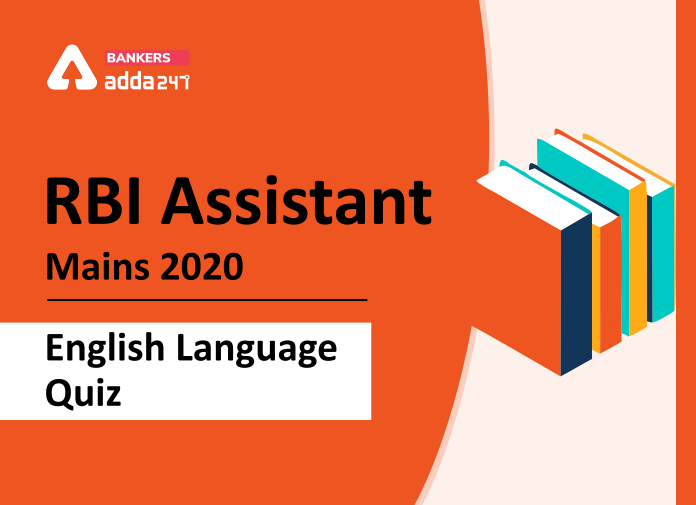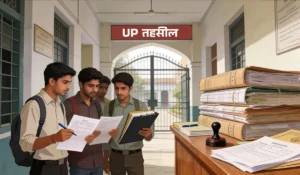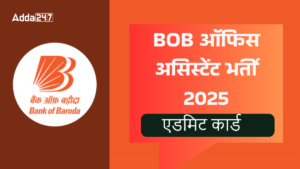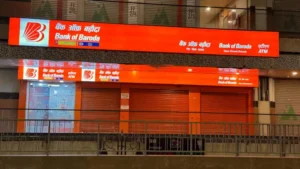
English Language Questions for RBI Assistant Mains 2020: The Reserve Bank of India will conduct the Main exam which is the final phase for the recruitment of Assistants. English Language is one of the sections students need to prepare for RBI Assistant Mains 2020 examination and here we are providing our students with daily mocks or quizzes in a new and simple pattern which will help you practice more effectively for the fight against 926 vacancies of RBI Assistant 2020 recruitment. We are providing you daily english quizzes based on the questions which were asked in previous days of RBI Assistant Mains examination and you can also check the study plan for RBI Assistant Mains to enhance your preparation. The quiz contains Practice Set Based Quiz. Stay with Bankers Adda for the latest Quizzes,Study notes,Test series, and other helpful study material.
Directions (1-8): Read the following passage and answer the following questions based on the given passage. Some of the words are highlighted which would help you to answer some of the questions given.
To understand the basic features of the Indian economy, and its development, as it is today, in the aftermath of Independence, it is equally important to know something about the country’s economic past even as you learn about its present state and future prospects. So, let us first look at the state of India’s economy prior to the country’s independence and form an idea of the various considerations that shaped India’s post-independence development strategy.
The structure of India’s present-day economy is not just of current making; it has its roots steeped in history, particularly in the period when India was under British rule which lasted for almost two centuries before India finally won its independence on 15 August 1947. The sole purpose of the British colonial rule in India was to reduce the country to be a raw material supplier for Great Britain’s own rapidly expanding modern industrial base. An understanding of the exploitative nature of this relationship is essential for any assessment of the kind and level of development which the Indian economy has been able to attain over the last six and half decades.
India had an independent economy before the advent of the British rule. Though agriculture was the main source of livelihood for most people, yet, the country’s economy was characterised by various kinds of manufacturing activities. India was particularly well known for its handicraft industries in the fields of cotton and silk textiles, metal and precious stone works etc. These products enjoyed a worldwide market based on the reputation of the fine quality of material used and the high standards of craftsmanship seen in all imports from India.
The economic policies pursued by the colonial government in India were concerned more with the protection and promotion of the economic interests of their home country than with the development of the Indian economy. Such policies brought about a fundamental change in the structure of the Indian economy — transforming the country into supplier of raw materials and consumer of finished industrial products from Britain.
Obviously, the colonial government never made any sincere attempt to estimate India’s national and per capita income. Some individual attempts which were made to measure such incomes yielded conflicting and inconsistent results. Among the notable estimators — DadabhaiNaoroji, William Digby, Findlay Shirras, V.K.R.V. Rao and R.C. Desai — it was Rao, whose estimates during the colonial period was considered very significant. However, most studies did find that the country’s growth of aggregate real output during the first half of the twentieth century was less than two per cent coupled with a meagre half per cent growth in per capita output per year.
India’s economy under the British colonial rule remained fundamentally agrarian — about 85 per cent of the country’s population lived mostly in villages and derived livelihood directly or indirectly from agriculture. However, despite being the occupation of such a large population, the agricultural sector continued to experience stagnation and, not infrequently, unusual deterioration. Agricultural productivity became low though, in absolute terms, the sector experienced some growth due to the expansion of the aggregate area under cultivation.
This stagnation in the agricultural sector was caused mainly because of the various systems of land settlement that were introduced by the colonial government. Particularly, under the zamindari system which was implemented in the then Bengal Presidency comprising parts of India’s present-day eastern states, the profit accruing out of the agriculture sector went to the zamindars instead of the cultivators.
However, a considerable number of zamindars, and not just the colonial government, did nothing to improve the condition of agriculture. The main interest of the zamindars was only to collect rent regardless of the economic condition of the cultivators; this caused immense misery and social tension among the latter. To a very great extent, the terms of the revenue settlement were also responsible for the zamindars adopting such an attitude; dates for depositing specified sums of revenue were fixed, failing which the zamindars were to lose their rights. Besides this, low levels of technology, lack of irrigation facilities and negligible use of fertilisers, all added up to aggravate the plight of the farmers and contributed to the dismal level of agricultural productivity. There was, of course, some evidence of a relatively higher yield of cash crops in certain areas of the country due to commercialisationof agriculture. But this could hardly help farmers in improving their economic condition as, instead of producing food crops, now they were producing cash crops which were to be ultimately used by
British industries back home. Despite some progress made in irrigation, India’s agriculture was starved of investment in terracing, flood-control, drainage and desalinisation of soil. While a small section of farmers changed their cropping pattern from food crops to commercial crops, a large section of tenants, small farmers and sharecroppers neither had resources and technology nor had incentive to invest in agriculure.
Q1. Given below are assessments of the kind and level of development which the Indian economy has been able to attain, made by three students of economics Manpreet, Raziya and Sunita. Understanding the sentiment of the author, upon reading the passage, choose that assessment(s) which according to the author should be a wrong assessment of the development which the Indian economy has attained. Assume information presented in the below statements to be true.
(I) Sunita says that development attained by the Indian economy is very limited as is reflected from the fact that India is not considered among the developed nations.
(II) Manpreet says that if one compares the health of the Indian economy at the time of Independence in 1947, one would realize that Indian economy has attained an impressive development.
(III) Raziya argued that the health of the Indian and the Chinese economy were approximately the same in 1947. Still, the present health of the Chinese economy is far better than that of the Indian economy. This reflects that Indian economy didn’t attained the level of development which she could have attained.
(a) Both (I) and (II)
(b) None of (I), (II) and (III)
(c) Only (III)
(d) Only (I)
(e) All of (I), (II) and (III)
Click here to Buy RBI Assistant Mains 2020 Study Material
Q2. Arrange the state of the health of Indian economy during different period in decreasing order based on the information given in the passage.
1: Before British Rule
2: Initial stage of British Rule
3: Final stage of British Rule
(a) 2>1>3
(b) 3>2>1
(c) 1>2>3
(d) 1>3>2
(e) None of the above
Q3. Kaviraj met Salima who is from Turkey wearing an antique gold bracelet embedded with a precious stone carefully crafted in the shape of peacock. Salima told Kaviraj that the bracelet belongs to her ancestors, was crafted in India but was purchased by her ancestor in Turkey. Based on the information given in the passage, which of the following time-period has the highest probability during which the bracelet would have been crafted and purchased, if the British colonial rule started in India in the year 1858?
(a) 1750-1760
(b) 1860-1900
(c) 1900-1910
(d) 1910-1920
(e) 1930-1940
Q4. What was the focus of the economic policies pursued by the colonial government in India?
(I) Protecting and promoting the economic interests of the home country of the colonial government.
(II) Developing the Indian economy.
(III) To provide livelihood to the large Indian population.
(a) Only (I)
(b) Only (II)
(c) Both (I) and (II)
(d) Only (III)
(e) None of the (I), (II) and (III)
Q5. Which of the following product has the highest probability to have been exported from India during 1900-1905, if one goes by the information presented in the passage considering that the British colonial rule started in 1858 and ended in 1947?
(a) A bicycle
(b) An ornamental fountain Pen
(c) Raw cotton
(d) Finished textile products
(e) Can’t be answered based on the passage
Practice for RBI Assistant Mains 2020 Exam with the latest study material:
Q6. Which of the following word has a meaning which is SIMILAR in meaning to the word ‘aggravate’?
(a) soothe
(b) mollify
(c) slump
(d) exacerbate
(e) gladden
Q7. Which of the following word has a meaning which is SIMILAR in meaning to the word ‘aggregate’?
(a) attempt
(b) measurement
(c) estimate
(d) output
(e) whole
Q8. Which of the following word has a meaning which is OPPOSITE in meaning to the word ‘advent’?
(a) emergence
(b) arrival
(c) growth
(d) departure
(e) defeat
Directions (9-13): In each of the following questions given below, a sentence is given with some bold words which may contain errors. Below each of the sentences, a table is given with two columns in which column ‘A’ contains the list of bold words, and in column ‘B’ the suggested corrections are listed. You have to choose the best alternate among the four given options. If no correction is required against the given bold words, mark (e) .i.e. “None of the above” as your answer.
Q9.The major attempts which States will be rated on is their success in reducing the cost of farm inputs by distributing soil health cards and encouraging organic farming and micro-irrigation. Risk levitation measures carry a 15% weightage, while increased productivity and investment in agriculture carry a 10% weight each.
COLUMN (A)
(1) attempts
(2) reducing
(3) levitation
(4) investment
COLUMN (B)
(5)parameter
(6) alluring
(7) mitigation
(8) Inclement
(a) Both (1) – (5) and (3) – (7)
(b) (2) – (6)
(c) (1) – (5)
(d) (3) – (7)
(e) None of the above
Q10. A Geographical Indication or a GI is a sign used on products that have a specific geographical origin and possess qualities or a fermentation that are due to that origin. Such a name conveys an assurance of quality and robustness which is essentially attributable to its origin in that defined geographical locality.
COLUMN (A)
(1) Products
(2) fermentation
(3)robustness
(4) origin
COLUMN (B)
(5) services
(6) reputation
(7)distinctiveness
(8) omission
(a) (4) – (8)
(b) (2) – (6)
(c) (1) – (5)
(d) Both (2) – (6) and (3-7)
(e) None of the above
Q11. In American Spanish, the capitalized term “El Niño” refers to “the boy”, so claimed because the pool of warm water in the Pacific near South America is often at its warmest around Christmas. The original name, “El Niño de Navidad”, traces its origin centuries back to Peruvian fishermen, who named the weathercriterionin reference to the newborn Christ.
COLUMN (A)
(1)claimed
(2)warmest
(3)traces
(4) criterion
COLUMN (B)
(5) named
(6) closest
(7) braces
(8)phenomenon
(a) (3) – (7)
(b) (2) – (6)
(c) (1) – (5)
(d) Both (1) – (5) and (4) – (8)
(e) None of the above
Q12.The “greenhouse effect” of the atmosphere is named by eulogy to greenhouses which become warmer in sunlight. However, a greenhouse is not primarily warned by the “greenhouse effect”. “Greenhouse effect” is actually a monomer since heating in the usual greenhouse is due trapping of heat.
COLUMN (A)
(1) eulogy
(2)sunlight
(3) warned
(4) monomer
COLUMN (B)
(5)analogy
(6) moonlight
(7) warmed
(8) misnomer
(a) (4) – (8)
(b) (2) – (6)
(c) Both (3) – (7) and (4) – (8)
(d) (1) – (5), (4) – (8) and (3) – (7)
(e) None of the above
Q13.Third-party clouds enable organizations to focus on their core businesses instead of pretending resources on computer infrastructure and provenance. Advocates note that cloud computing allows companies to avoid or minimize up-front IT infrastructure costs.
COLUMN (A)
(1) enable
(2) pretending
(3) provenance
(4) avoid
COLUMN (B)
(5) durable
(6)expending
(7) maintenance
(8) devoid
(a) (4) – (8)
(b) (2) – (6)
(c) Both (2) – (6) and (3) – (7)
(d) (1) – (5), (2) – (6) and (3-7)
(e) None of the above
Get the top selling video course and books for RBI Assistant Mains 2020 Preparation:
Directions (14-15) Each of the following questions has a paragraph from which one sentence has been deleted. From the given options, choose the one that completes the paragraph in the most appropriate/coherent way.
Q14. To make the pulmonary TB diagnosis portable, the researchers bound the aptamer to an electrode coated with gold nanoparticles. When the sample containing the HspX antigen is added, __________________________________________________________ undergoes a structural change, which is read out in the electrical signal. There is a drop in electrical signal if the sample is positive and no change in signal when the sample is negative.
(a)The aptamer is then added followed by a substrate
(b)The aptamer binds to the antigen and
(c)The aptamer reagent and have licensed it to
(d)The aptamer-based lab diagnosis was far superior to
(e) None of these
Q15. The information on the South African leader came days after the United States confirmed that President Donald Trump will not be the Chief Guest of Republic Day in India due to his pressing schedule in January. _________________________, and succeeded Jacob Zuma who had to leave following allegations of corruption. MrRamaphosa is also the current head of the African National Congress (ANC).
(a)The chemical companies are also letting out untreated effluents into the waters
(b) Mr. Ramaphosa had hosted Prime Minister NarendraModi during the BRICS
(c)Strict environmental regulations should be imposed and salt pan and other aquaculture practices
(d)MrRamaphosa became President of South Africa in February this year
(e) None of these
Solutions
S1. Ans. (d)
Sol. The answer to the question can be derived from the last sentence of the first paragraph ‘An understanding of the exploitative nature of this relationship is essential for any assessment of the kind and level of development which the Indian economy has been able to attain over the last six and half decades’. From the highlighted sentence, the sentiment of the author of the passage can be understood. According to author, correct assessment about the development which the Indian economy has attained over the last six and half decades (i.e., after Independence) requires an understanding of the exploitative nature of the British colonial rule in India’. From the sentence, it could be inferred that the health of the Indian economy was pathetic at the time of Independence. So, the assessment about the kind and level of Indian economy has attained till now after Independence must take into consideration the health of the Indian economy at the time of Independence. The assessments made by Manpreet and Raziya consider the health of the Indian economy in 1947 (the year when India attained Independence), but the assessment made by Sunita doesn’t take into account the health of the Indian economy at the time of India’s Independence. So, the author should NOT agree with the kind of assessment made by the Sunita.
Hence, the option (d) is the correct answer.
S2. Ans. (c)
Sol. The answer to the question can be derived from the third paragraph and the fourth paragraph. The paragraph suggests that the economic policies pursued by the British colonial government destroyed the Indian economy as the British colonial rule progressed.
So, the state of the health of the Indian economy would have decayed over the course of time during the British colonial rule.
Hence, the correct sequence should be 1>2>3 and option (c) should be the correct answer.
S3. Ans. (a)
Sol. The last sentence of the third paragraph is ‘Such policies brought about a fundamental change in the structure of Indian economy—transforming the country into supplier of raw materials and consumer of finished industrial products from Britain’.
The jewelry mentioned in the question is a finished stone-work product for which India was famous for in the world before the advent of the British colonial rule. The question mentions that the British rule was started in 1858 and ended in 1947. It would be near-impossible for a finished jewelry product to be imported from India during the British rule. Hence, the time period 1750-1760 has the highest probability during which the bracelet would have been crafted and purchased.
Hence, the option (a) is the correct answer.
S4. Ans. (a)
Sol. The answer to the question can be derived from the first sentence of the third paragraph ‘The economic policies pursued by the colonial government in India were concerned more with the protection and promotion of the economic interests of their home country than with the development of the Indian economy’.
Clearly, only (I) is correct and hence, the option (a) is the correct answer.
S5. Ans. (c)
Sol. The answer to the question can be derived from the last sentence of the third paragraph is ‘Such policies brought about a fundamental change in the structure of Indian economy—transforming the country into supplier of raw materials and consumer of finished industrial products from Britain’.
Among the given options, the options (a), (b) and (d) are finished product while the option (c) is a raw material. So, the option (c) has the highest probability of being exported during the mentioned time period which lies in the British colonial era.
Hence, the option (c) is the correct answer.
S6. Ans. (d)
Sol. aggravate [verb] means ‘make (a problem, injury, or offence) worse or more serious’;
Soothe [verb] means ‘reduce pain or discomfort in (a part of the body)’;
Mollify [verb] means ‘appease the anger or anxiety of (someone)’;
Exacerbate [verb] means ‘make (a problem, bad situation, or negative feeling) worse’;
Gladden [verb] means ‘make glad’;
From above, it could be understood that the word ‘exacerbate´ has a meaning which is similar to the meaning of ‘aggravate’.
S7. Ans. (e)
Sol. ‘aggregate’ means ‘a whole formed by combining several separate elements’;
The word ‘whole’ has a meaning closer to the meaning ‘aggregate’ and hence, is the correct answer.
Hence, the option (e) is the correct answer.
S8. Ans. (d)
Sol. ‘advent’ [noun] means ‘the arrival of a thing’;
Departure [noun] means ‘the action of leaving, especially to start a journey’.
Emergence and arrival are synonyms of the word ‘advent’.
Hence, the option (d) is the correct answer.
S9. Ans. (a)
Sol. The paragraph is talking about the new index, soil health card to check ease of doing agri-business.
Levitation- the action of rising or causing something to rise and hover in the air, typically by means of supposed magical powers.
Mitigation- the action of reducing the severity, seriousness, or painfulness of something
Alluring- powerfully and mysteriously attractive or fascinating; seductive
Inclement- (of the weather) unpleasantly cold or wet
Word ‘levitation’ is totally out of context to the given paragraph.
Hence, option (a) is the most suitable answer choice.
As the Paragraph is stating that ‘States will be rated’ so the rating should be done based on some ‘parameters’ not based on some ‘attempts’.
S10. Ans. (d)
Sol. The paragraph is talking about the GI’s. which are defined as “Indications which identify a good as originating in the territory of a member, or a region or a locality in that territory, where a given quality, reputation or characteristic of the good is essentially attributable to its geographic origin”
Fermentation- the chemical breakdown of a substance by bacteria, yeasts, or other microorganisms, which is totally out of context of the given stanza
Robustness- the quality or condition of being strong and in good condition;
Distinctiveness- the quality of being individual or easily distinguishable;
Hence option (d) is the most suitable answer choice
S11. Ans. (d)
Sol. The paragraph is talking about the El Nino, a weather phenomenon caused when warm water from the western Pacific Ocean flows eastward, and it states how the effects of El Nino can be noticed in many parts of the world, with different regions experiencing varying weather anomalies.
El Nino is a weather phenomenon not a criterion.
Hence, option (d) is the most suitable answer choice.
S12. Ans. (d)
Sol. The paragraph is talking about the “greenhouse effect”, a process by which radiation from a planet’s atmosphere warms the planet’s surface to a temperature above what it would be without its atmosphere.
Eulogy- a speech or piece of writing that praises someone or something highly, especially a tribute to someone who has just died, which is totally out of context.
Analogy is the correct choice as it means “a comparison between one thing and another, typically for the purpose of explanation or clarification.”
Misnomer- a wrong or inaccurate name or designation
Monomer- a molecule that can be bonded to other identical molecules to form a polymer
It can be clearly identified that ‘monomer’ is totally out of context to the stanza.
Hence, option (d) is the most suitable answer choice.
S13. Ans. (c)
Sol. The paragraph is talking about the how the ‘third-party clouds’ are benefitting the organization.
Provenance means the place of origin or earliest known history of something which it totally out of context of the given stanza.
‘pretending resources’ doesn’t add any meaningful sense to the given stanza hence it should be ‘expanding resources’
Devoid- entirely lacking or free from
Hence, option (c) is the most suitable answer choice.
S14. Ans. (b)
Sol. The Stanza explains that how the aptamer was made portable to run a rapid diagnose test. Option (d) can be easily omitted as ‘superior to’ implies the comparison, which is not mentioned anywhere in the stanza. Word ‘antigen’ would be helpful for us to select the correct alternative, as the stanza explains when ‘antigent’ is added to aptamer, how it responds to that; it binds to the antigen and then undergoes some structural change. Among all the given options, only alternative (b) aptly fits in the blank and forms a coherent paragraph. Hence, option (b) is the most suitable answer choice.
S15. Ans. (d)
Sol. The options (a) and (c) are completely irrelevant. The option (b) doesn’t gel with the later part of the sentence where the blank is appearing from the contextual point of view, only option (d) does so. Hence, the option (d) is the most suitable answer choice.
Download PDF of this English Quiz for RBI Assistant Mains 2020
Visit here to discuss all your queries related to Government Exams
Practice with Crash Course and Online Test Series for RBI Assistant Mains 2020:
- Bank Maha Pack (1 Year Validity)
- RBI Assistant Mains 2020 Online Test Series
- RBI Assistant Mains 2020 Video Course
Register Here for Bank Exams 2020 Preparation
If you are preparing for RBI Assistant Mains 2020, then you can also check out a video for English Language below:



 UPSSSC ने लेखपाल के 7994 पदों पर निकाली ...
UPSSSC ने लेखपाल के 7994 पदों पर निकाली ...
 BOB ऑफिस असिस्टेंट एडमिट कार्ड 2025: जान...
BOB ऑफिस असिस्टेंट एडमिट कार्ड 2025: जान...
 BOB ऑफिस असिस्टेंट परीक्षा तिथि 2025 जार...
BOB ऑफिस असिस्टेंट परीक्षा तिथि 2025 जार...








